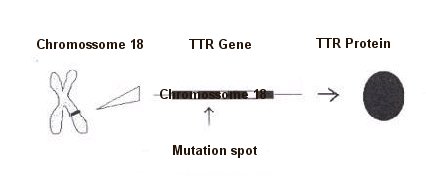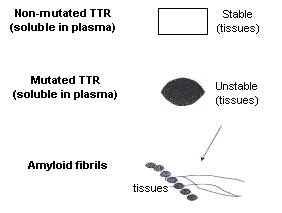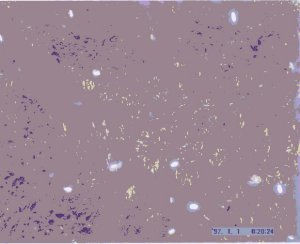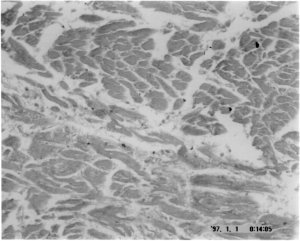|
|
|

Nucleotide in adenine
-> nucleotide in guanine
Gene - sequence of nucleotides
that contains information for the construction of a definite
protein
Nucleotide - structural unit of the nucleic
acids.
Aminoacid - structural unit of
proteins. |
|
Amyloid
fibrils result from a mutation on the long arm of chromosome
18 of the gene encoding transthyretin (TTR).
The
substitution, in this gene, of a single nucleotide in adenine
for one in guanine (the bases of nucleotides) at position 30,
originates aminoacid methionine (MET) instead of valine, which
results in a protein with different characteristics.
As it is
dominant, if the individuals are homozygotic (have both
elements of the pair chromosome 18 with mutation) they have
100% probability of transmitting the disease to their
descendants. If they are heterozygotic (only one of the
chromosomes is affected) probability drops to 50 %. Being
either homo or heterozygotic does not seem to aggravate the
symptoms, as there are cases of assymptomatic
homozygotes.
|
 |
Whereas normal TTR
is soluble in plasma and stable in tissues, mutant is soluble
in plasma but unstable in the tissues, polymerising and
forming amyloid fibrils.
|
|
When examined in the
polarising microscope, fibrils look greenish, due to the
double refraction of incident light.
|
 |
Deposition of amyloid on a FAP tissue
examined in the polarizing microscope.
(Amyloid Unit,
IMCB, Rui Fernandes) |
|
As there are other
proteins capable of polymerizing, when the researchers examine
amyloid deposits in tissues and want to make sure it is TTR,
they colour them with antibodies specific to that protein,
obtained after injecting TTR into an animal that recognises it
as a different protein.
|
 |
Location of TTR deposits on muscular
tissue coloured with antibodies.
(Amyloid Unit, IMBC,
Rui Fernandes) |
|
TTR is a tetrameric
protein (composed of four subunits) related to the transport
of RBP (Rethinol Binding Protein) lipids and thyroxin ( the
thyroid gland hormone). If the individual is homozygotic, he
has the four mutated subunits, if he is heterozygotic he may
have one, two or three. However, if the mechanism of the fibre
deposition is the same, which is still being investigated, it
does not matter whether he is homo or heterozygotic.
There are other TTR mutations, some of
which non-pathogenic, that are associated with MET 30. Six
families with double mutation (MET30 and Met 119) have been
identified in our country and it has been found that they
presented a later onset and a slower progression of the
disease. According to Maria Joćo Saraiva, the protection given
by the second mutation (Met 119) to the clinical symptoms is
due to the fact that fibrils will not be formed unless TTR
dissociates into its four subunits. As MET 30 does it more
easily and MET 119 offers great resistance to that separation
, the association of both mutations weakens
symptoms.
|
|